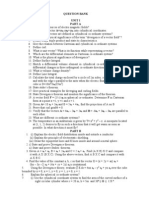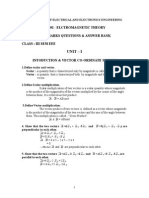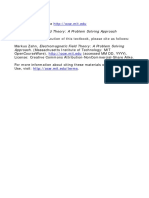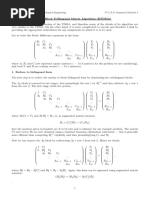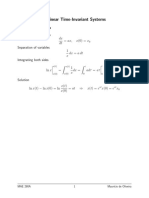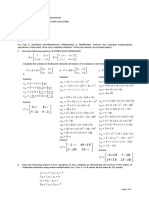0 ratings0% found this document useful (0 votes)
22 viewsAssignment 2
This document contains 14 problems involving vector calculus concepts like gradient, divergence, and curl in various coordinate systems including cartesian, cylindrical, and spherical coordinates. The problems involve evaluating these operators for scalar and vector fields, expressing coordinate transformations, solving Laplace's equation, and finding representations of vectors in different coordinate systems.
Uploaded by
sameed hussainCopyright
© © All Rights Reserved
Available Formats
Download as PDF, TXT or read online on Scribd
0 ratings0% found this document useful (0 votes)
22 viewsAssignment 2
This document contains 14 problems involving vector calculus concepts like gradient, divergence, and curl in various coordinate systems including cartesian, cylindrical, and spherical coordinates. The problems involve evaluating these operators for scalar and vector fields, expressing coordinate transformations, solving Laplace's equation, and finding representations of vectors in different coordinate systems.
Uploaded by
sameed hussainCopyright
© © All Rights Reserved
Available Formats
Download as PDF, TXT or read online on Scribd
You are on page 1/ 2
Assignment 2 EP1118
⃗ . (𝑟 𝑛 𝑟) vanishes for n=-3.
1. Show that ∇
2. A particle is moving in space. Show that the divergence of its
position vector is invariant under coordinate transformation. (show
in all cartesian, cylindrical and spherical coordinates.)
3. The magnetic potential of a single current loop in the xy-plane is
𝜙 𝜙 (𝑟, 𝜃 )]. Express it in spherical polar
given by 𝑉 = ∇ × [∇ × 𝑒̂𝐴
coordinates.
4. Solve the Laplace equation ∇2 𝜓 = 0 in cylindrical coordinates for
𝜓 = 𝜓(𝜌).
5. Given f(r) is a function of r, expressing ⃗∇ in spherical polar
𝑑𝑓(𝑟)
coordinates show that ⃗∇𝑓 (𝑟) = 𝑟̂ .
𝑑𝑟
6. Evaluate ⃗∇𝑟 𝑛 . (use spherical polar coordinates)
7. Find the gradient of the following scalar field at given point
(i) 𝜒 = 2𝑧 2 𝜌 𝑐𝑜𝑠𝜙 𝑎𝑡 (1, 𝜋/2, −1)
(ii) 𝜒 = 2𝑟𝑠𝑖𝑛𝜃 𝑐𝑜𝑠𝜙 𝑎𝑡 (1, 𝜋/2, 𝜋)
8. Determine the divergence of the following vector field
(i) 𝜌𝑠𝑖𝑛𝜙 𝜌̂ + 𝜌2 𝑧 𝜙̂ + 𝑧𝑐𝑜𝑠𝜙 𝑧̂
1
(ii) ̂ ̂
2 𝑐𝑜𝑠𝜃 𝑟̂ + 𝑟𝑠𝑖𝑛𝜃𝑐𝑜𝑠𝜙 𝜃 + 𝑐𝑜𝑠𝜃 𝜙
𝑟
(iii) 𝜌(2 + 𝑠𝑖𝑛2 (𝜃 ))ρ̂ + 𝜌𝑠𝑖𝑛𝜙𝑐𝑜𝑠𝜙𝜙̂ + 3𝑧𝑧̂
(iv) 𝜌𝑠𝑖𝑛𝜙𝜌̂ + 𝜌2 𝑧𝜙̂ + 𝑧𝑐𝑜𝑠𝜙𝑧̂
9. Calculate the curl of the vector field
𝜌
𝑐𝑜𝑠ℎ 𝜌
̂ρ + 𝑠𝑖𝑛2𝜙 𝑙𝑛 √
2
𝐺 (𝜌, 𝜙, 𝑧) = −𝑐𝑜𝑠 𝜙𝑡𝑎𝑛ℎ𝜌 h ℎ̂ϕ
𝑐𝑜𝑠ℎ 𝑧
+ 𝑐𝑜𝑠 2 𝜙 𝑡𝑎𝑛ℎ 𝑧 ̂
hz
10. A new set of coordinates is defined by the relationship
𝛼 𝛽
𝑥= ,𝑦 = ,𝑧 = 𝛾
𝛼 2 +𝛽 2 𝛼 2 +𝛽 2
Determine the gradient in this system for an arbitrary function 𝜙.
11. Derive the divergence of the vector field
𝑥 2𝑦
𝐹 = (𝑥 2 𝑖̂ + √𝑥 2 + 𝑦 2 𝑗̂ + 𝑧(1 − 𝑥 2 − 𝑦 2 )𝑘̂
+𝑦 2 )2
in cylindrical coordinates.
12. Find the components of a vector 𝐴 = 2𝑦𝑖̂ − 3𝑗̂ + 2𝑧𝑘̂ in
cylindrical polar coordinate system.
13. Find the location of point (1,1,1) in cylindrical and spherical
coordinate systems.
⃗ 𝐹 (b)
14. 𝐹 = 𝜌3 𝑠𝑖𝑛 𝜑 (In cylindrical polar coordinate) find (a) ∇
Show that the result from (a) is consistent when we use cartesian
coordinates.
You might also like
- Mathematical Techniques An Introduction For The Engineering, PH PDF100% (8)Mathematical Techniques An Introduction For The Engineering, PH PDF812 pages
- 8-2 Vectors in The Coordinate Plane: Esolutions Manual - Powered by CogneroNo ratings yet8-2 Vectors in The Coordinate Plane: Esolutions Manual - Powered by Cognero35 pages
- Department of Electronics and Communication Engineering Semester-V Engineering Electromagnetics100% (1)Department of Electronics and Communication Engineering Semester-V Engineering Electromagnetics3 pages
- A Vector in The Direction of Vector That Has Magnitude 15 IsNo ratings yetA Vector in The Direction of Vector That Has Magnitude 15 Is8 pages
- NTHU Electrical Engineering Department EE2140 Electromagnetics Spring 2024 HW #1No ratings yetNTHU Electrical Engineering Department EE2140 Electromagnetics Spring 2024 HW #12 pages
- Electromagnetic Field Theory: A Problem Solving ApproachNo ratings yetElectromagnetic Field Theory: A Problem Solving Approach11 pages
- Sessional Examination, 2015-2016: Hi-Tech Institute of Engineering and Technology B.Tech (EE, V SEM)No ratings yetSessional Examination, 2015-2016: Hi-Tech Institute of Engineering and Technology B.Tech (EE, V SEM)1 page
- Practice Sheet 26 Integral of Vector FunctionNo ratings yetPractice Sheet 26 Integral of Vector Function2 pages
- PH424 - Electromagnetic Theory I: Basanta K. Nandi x7560No ratings yetPH424 - Electromagnetic Theory I: Basanta K. Nandi x756030 pages
- 8-5 Dot and Cross Products of Vectors in Space-3No ratings yet8-5 Dot and Cross Products of Vectors in Space-330 pages
- Joseph D. Fehribach - Multivariable and Vector Calculus (2020, de Gruyter) (10.1515 - 9783110660609) - Libgen - LiNo ratings yetJoseph D. Fehribach - Multivariable and Vector Calculus (2020, de Gruyter) (10.1515 - 9783110660609) - Libgen - Li180 pages
- CBSE Sample Papers For Class 12 Maths Set 11 With Solutions - Merit BatchNo ratings yetCBSE Sample Papers For Class 12 Maths Set 11 With Solutions - Merit Batch1 page
- QE Determinant & Matrices SOLUTION FOR DROPPER PDFNo ratings yetQE Determinant & Matrices SOLUTION FOR DROPPER PDF37 pages
- L15 1Basic Matrix Transformations in R2 and R3 12122024 103226pmNo ratings yetL15 1Basic Matrix Transformations in R2 and R3 12122024 103226pm56 pages
- NCERT Solutions For Class 12 Maths Chapter 4 Determinants Exercise 4.4No ratings yetNCERT Solutions For Class 12 Maths Chapter 4 Determinants Exercise 4.45 pages
- Estimated Mass and Stiffness Matrices of Shear Building From Modal Test DataNo ratings yetEstimated Mass and Stiffness Matrices of Shear Building From Modal Test Data7 pages
- 1 Solution To Linear Time-Invariant Systems: MAE 280A 1 Maur Icio de OliveiraNo ratings yet1 Solution To Linear Time-Invariant Systems: MAE 280A 1 Maur Icio de Oliveira11 pages
- Chapter 5: Stationary Perturbation Theory: (From Cohen-Tannoudji, Chapter XI)No ratings yetChapter 5: Stationary Perturbation Theory: (From Cohen-Tannoudji, Chapter XI)46 pages



